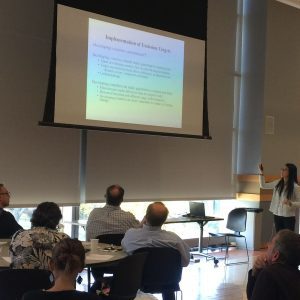 The Early College Experience (ECE) Economics Program presented a workshop on October 31 for Connecticut high school teachers offering Principles of Micro and Macro Economics (Econ 1201 and 1202) and Essentials of Economics (Econ 1000) in their high schools. The economics program now has certified 39 instructors as either Adjunct Professors of Economics or Preceptors in Economics. Twenty-nine of them choose to attend the workshop.
The Early College Experience (ECE) Economics Program presented a workshop on October 31 for Connecticut high school teachers offering Principles of Micro and Macro Economics (Econ 1201 and 1202) and Essentials of Economics (Econ 1000) in their high schools. The economics program now has certified 39 instructors as either Adjunct Professors of Economics or Preceptors in Economics. Twenty-nine of them choose to attend the workshop.
The teachers were instructed on the economics of climate change by Wensu Li, one of UCONN’s knowledgeable graduate students who discussed what one could teach in the principles classes about climate change. Professor Paul Tomolonis, Assistant Professor of Economics, Western New England University and Adjunct Professor of Economics University of Connecticut, reflected on earnings management with the workshop participants.  He used earnings managment as an example of misallocation of resources. Professor Stephen L. Ross, Professor of Economics, University of Connecticut described the importance of distinguishing between permanent shocks and transitory shocks to the macro economy and the day was concluded with Professor Dennis Heffley, Professor of Economics, University of Connecticut, Emeritus who addressed the workshop on the teaching of health economics at the principles level.
He used earnings managment as an example of misallocation of resources. Professor Stephen L. Ross, Professor of Economics, University of Connecticut described the importance of distinguishing between permanent shocks and transitory shocks to the macro economy and the day was concluded with Professor Dennis Heffley, Professor of Economics, University of Connecticut, Emeritus who addressed the workshop on the teaching of health economics at the principles level.
Finally, three of the teachers (Ms. Vancil, Shelton, Ms. Pelling, West Hartford, and Mr. Staffaroni from New Canaan) spent a few minutes over lunch to shared one of their learning experiences with their colleagues gained while attending the Joint Council on Economic Education Conference in New York City in early October.
UCONN ECE is a concurrent enrollment program that allows motivated high school students to take UCONN courses at their high schools for both high school and college credit. Every course taken through UCONN ECE is equivalent to the same course at the University of Connecticut. Students benefit by taking college courses in a setting that is both familiar and conducive to learning. High school instructors who have been certified through the University of Connecticut serve as adjunct faculty members and teach UCONN ECE courses. Established in 1955, UCONN ECE is the nation’s longest running concurrent enrollment program and is accredited by The National Alliance of Concurrent Enrollment Partnerships.